RBSE Class 12 Physics Notes Chapter 3 Current Electricity
These comprehensive RBSE Class 12 Physics Notes Chapter 3 Current Electricity will give a brief overview of all the concepts.
Rajasthan Board RBSE Solutions for Class 12 Physics in Hindi Medium & English Medium are part of RBSE Solutions for Class 12. Students can also read RBSE Class 12 Physics Important Questions for exam preparation. Students can also go through RBSE Class 12 Physics Notes to understand and remember the concepts easily. Browsing through wave optics important questions that include all questions presented in the textbook.
RBSE Class 12 Physics Chapter 3 Notes Current Electricity
Electric Current And Resistance:
It is the rate of flow of charge and its unit is ampere.
∴ Electric current, I = \(\frac{q}{t}=\frac{n e}{t}\) 1 Cs-1(A)
Direction of current is direction of flow of positive charge and is called conventional current.
Ohm’s law:
It states that the current flowing through a conductor is proportional to the potential difference across its two ends provided the physical conditions (temperature, mechanical strain etc.) of the conductor remain unchanged.
i.e. V ∝ I
or V = RI
R is the constant of proportionality and is called the resistance of the conductor.
V ,
And R = y = VA-1 = ohm (Ω)
The resistance of a conductor depends upon
R ∝ l, R ∝ \(\frac{l}{A}\)
or R ∝ \(\frac{l}{A}\)
or R = ρ\(\frac{l}{A}\)
And also ρ = \(\frac{m}{n e^2 \tau}\)
where ρ is called resistivity or specific resistance of the material.
Conductance is reciprocal of resistnce
i. e. G = \(\frac{1}{R}\) = Ω-1 or siemen (S)
Conductivity is reciprocal of resistivity
i. e. ρ = \(\frac{1}{\sigma}\) = Sm-1

Drift Velocity:
Drift Velocityis the velocity of free electrons with which they get drifted towards the positive terminal under the influence of external field.
Drift velocity is given by
vd = \(\frac{\mathrm{I}}{n e \mathrm{~A}}\)
Also vd = \(\frac{e \mathrm{E} \tau}{m}\)
where r is the average time for which each electron is accelerated before suffering a collision called average relaxation time.
Colour code:
A colour code is used to indicate the resistance value and its percentage reliability. To find the resistance value, following sentence is used.
B B ROY Great Britain Very Good Wife
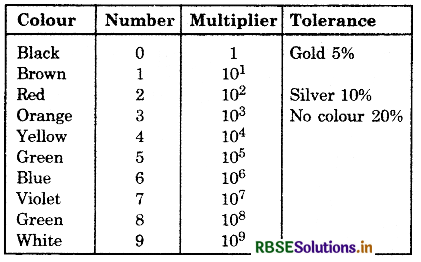
Combination of resistances:
When resistances are connected in series, equivalent resistance is equal to sum of individual resistances
i. e. RS = R1 + R2 + ....................
When resistances are connected in parallel reciprocal of equivalent resistance is equal to sum of reciprocals of individual resistances.
i.e \(\frac{1}{\mathrm{R}_p}=\frac{1}{\mathrm{R}_1}+\frac{1}{\mathrm{R}_2}\)+ .................
Grouping of cells:
In series combination of cells to have maximum current, the total internal resistance of the cells should be negligible as compared to the external resistance of the circuit.
The current flowing through the circuit
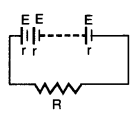
I = \(\frac{n \mathrm{E}}{\mathrm{R}+n r}\), n is the number of cells and r is the internal resistance of each cell, R is the external resistance.
In parallel combination of cells, to have maximum current, the total external resistance of the circuit should be negligible as compared to the total internal resistance of the cells.
The current through the circuit.
I = \(\frac{\mathrm{E}}{\mathrm{R}+\frac{r}{m}}\)
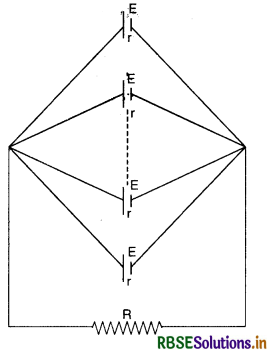
- E.M.F. of cell (E) is the maximum potential difference between two electrodes of cell, when the circuit is open i.e. no current is drawn from the cell.
- Internal resistance of a cell (r) is the resistance offered by the electrolyte and electrodes of a cell to the passage of electric current through the cell.
- Terminal potential difference (V) of a cell is the potential difference between the two electrodes of a cell, when the circuit is closed i.e. when current is drawn from the cell.
And V= E - Ir - And internal resistance of a cell is given by
r = \(\left(\frac{\mathrm{E}-\mathrm{V}}{\mathrm{V}}\right)\)R = (\(\frac{E}{V}\) - 1)R

Electric Measurements:
Kirchhoffs laws. Ohm’s law is used in simple electrical circuits and if the circuit contains more than one source of e.m.f. we use Kirchhoffs laws.
(i) Kirchhoffs first law or junction rule. It states that the algebraic sum of currents meeting at a point is zero.
i.e. Σi = 0
It means that the current entering a point must be the same as that leaving it. Hence there cannot be any accumulation of current at any point in a conductor.
(ii) Kirchhoffs second law or loop rule. It states that in a closed electric circuit, the algebraic sum of e.m.f.’s is equal to the algebraic sum of the products of the resistance and current flowing through them.
i.e. ΣE = ΣiR
Wheatstone bridge:
It is used for measuring unknown resistances and is based on the principle that if four resistances P, Q, R and S are arranged to form a bridge as shown in the figure and the bridge is balanced i.e. the
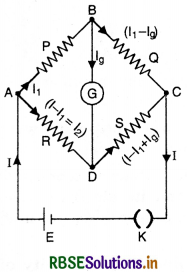
galvanometer does not show any deflection, then
\(\frac{\mathrm{P}}{\mathrm{Q}}=\frac{\mathrm{R}}{\mathrm{S}}\)
Slide wire bridge:
It is the practical form of Wheatstone bridge. It consists of uniform wire AC, usually one metre long, soldered at both ends of two thick rectangular strips of copper A and C on a wooden box. R is known resistance and S is unknown resistance and is given by
S = \(\frac{100-l}{l}\)R
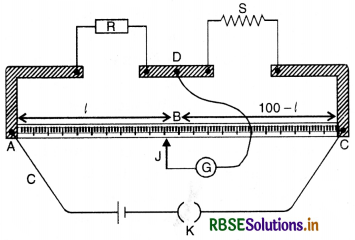
Potentiometer:
The potentiometer is an instrument which is used for measuring the e.m.f. or potential difference between two points in an electrical circuit accurately and also used to compare the emfs of two cells and for measuring the internal resistance of a cell.
Comparison of emfs of two cell is given by
\(\frac{\mathrm{E}_1}{\mathrm{E}_2}=\frac{l_1}{l_2}\)
where l1 and l2 are the balanced points obtained by two cells respectively.
And internal resistance of a cell is given by
r = \(\left(\frac{l_1-l_2}{l_2}\right)\)R = (\(\frac{l_1}{l_2}\) - 1)R
where l1 and l2 be the lengths of wire giving balance points of two cells without and with external resistance R.
Heating Effect of Current:
It is found that, whenever an electric current is passed through a conductor heat is produced. This is called heating effect of current or Joule heating effect. Heat produced is given by
H ∝ I2Rt
or H = I2Rt joule = (IR) It = VIt joule
or H = \(\frac{\mathrm{I}^2 \mathrm{R} t}{4.18}\)cal or \(\frac{\mathrm{I}^2 \mathrm{R} t}{4.2}\)cal

Electric energy (W):
It is the total work done (or energy supplied) by the source of e.m.f. in maintaining the electric current for a given time.
If V is the potential difference across two ends of a resistance and q charge is passed for time t, then
Energy gained (or work done) W = Vq = Vlt
= IR (It)
or W = I2Ri
If I is in ampere, R is in ohm and t in seconds, then W is in joule.
Electric power (P):
The rate at which electric work is done by the source of e.m.f. in maintaining the current in a circuit is called electric power of the circuit and is given by
P = \(\frac{\mathrm{W}}{t}=\frac{\mathrm{VI} t}{t}\) = VI
In SI, the unit of electric power is watt (or Js _1)
And 1 watt = 1V × 1A
Also P= VI = (IR)I = I2R
And P = VI = V\(\left(\frac{V}{R}\right)=\frac{V^2}{R}\)
Watt hour:
Generally, electric energy consumed is measured in joule but another unit for electric energy consumed or dissipated is called watt hour. i.e. 1 watt hour = 1 watt × 1 hour The energy consumed or dissipated in an electric circuit is called one watt hour, if the source of electric power of 1 watt is used for 1 hour.
Commercial unit of electric energy is called kilowatt-hour (kWh)
1 kWh is the total energy consumed by an electrical appliance of power ,tkW is used for 1 hour
1 kWh = 1000 Wh
= (1000 W) (60 × 60s)
= 3.6 × 106 J

- RBSE Class 12 Physics Notes Chapter 2 स्थिर वैद्युत विभव तथा धारिता
- RBSE Class 12 Physics Notes Chapter 3 विद्युत धारा
- RBSE Class 12 Physics Notes Chapter 4 गतिमान आवेश और चुंबकत्व
- RBSE Class 12 Physics Notes Chapter 5 चुंबकत्व एवं द्रव्य
- RBSE Class 12 Physics Notes Chapter 6 वैद्युत चुंबकीय प्रेरण
- RBSE Class 12 Physics Notes Chapter 7 प्रत्यावर्ती धारा
- RBSE Class 12 Physics Notes Chapter 8 वैद्युतचुंबकीय तरंगें
- RBSE Class 12 Physics Notes Chapter 9 किरण प्रकाशिकी एवं प्रकाशिक यंत्र
- RBSE Class 12 Physics Notes Chapter 10 तरंग-प्रकाशिकी
- RBSE Class 12 Physics Notes Chapter 11 विकिरण तथा द्रव्य की द्वैत प्रकृति
- RBSE Class 12 Physics Notes Chapter 12 परमाणु